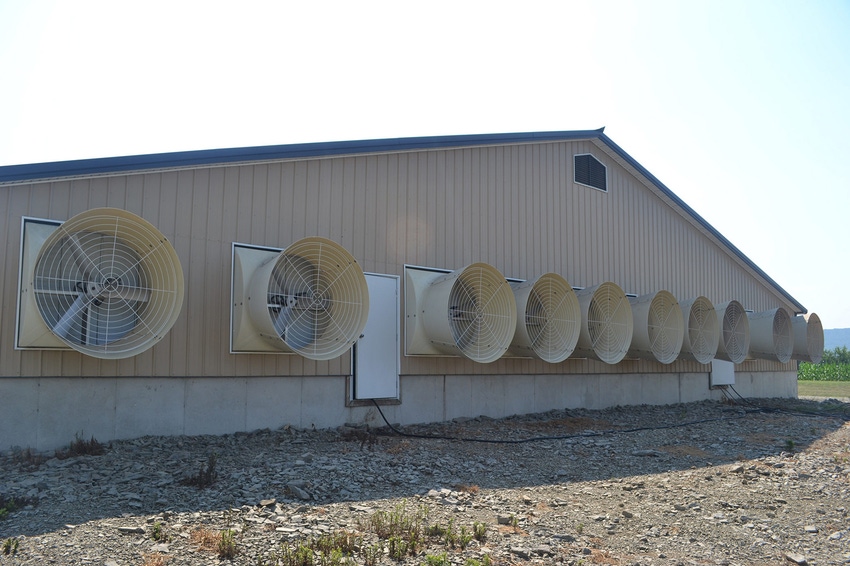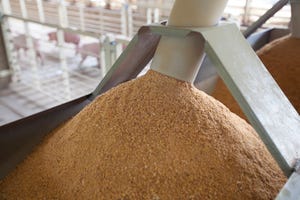Total infiltration rate was lower for rooms from a single barn layout and rooms having a non-metal ceiling and aged less than 13 years.
February 21, 2018

By Brett C. Ramirez and Steven J. Hoff, Iowa State University Department of Agricultural and Biosystems Engineering
About this time last year, I wrote a column about the general concept of infiltration and the negative impacts it can have on the buildings, the ventilation system and the pigs. Because it is such an important concept during the winter, when the minimum ventilation stage is frequently used, I thought we would re-visit it now that a recent study by Iowa State University has been completed and published in Applied Engineering in Agriculture. The methods and some results of this study were briefly discussed in last year’s column, but this is a good time to summarize the study in more detail and introduce the results to prepare for next month’s column on the more practical implications.
A quick recap on what is infiltration. During the winter, it is often difficult to provide an environment inside your barn that is acceptable for both animals and workers. Even if the correct ventilation rate is provided, how that fresh air is distributed within the room is critical for the quality of the environment and performance of the animals. Ideally, during the minimum and low stages, all fresh air should pass through the planned ceiling inlets when a pressure difference is created across the inlets by the fans. However, numerous factors allow cold, fresh air to enter the room through unplanned inlets (“leaks”) in ceiling/wall joints, pit covers, shutters, doors, building shell, curtains, etc. Fresh air not entering the room through the inlets is known as infiltration and can reduce air quality, be a common source of drafts and decrease ventilation effectiveness.
Back to the study. This is part one of several that the Iowa Pork Producers Association funded to measure how leaky facilities are, what can be done, and how it impacts the design of future facilities. A total of 17 wean/grow-finish rooms across Iowa were tested and passed quality control. These rooms varied in age (2 to 22 years old), facility layout (single room, double-wide, H-type, double-wide + H-type), pit type (deep, shallow), ceiling material (metal, plastic, polyethylene), room dimensions (length: 124 to 237 feet; width: 40 to 60 feet), number of fans (with or without shutters), sidewall/endwall curtain areas, and number of pump-outs. The test procedure was performed using the CGSB 149.15-96 (1996) and ASTM E779-10 (2010) standard, which are both suited for single-zone rooms (most common livestock and poultry facilities).
Essentially, to test a room, a static pressure difference was generated across the room envelope by exhausting varied quantities of air from the room. Three tests (denoted Test I, II and III) were conducted on each power-washed room. Test I was the total infiltration test where only the primary ceiling inlet system was sealed airtight (using a lot of duct tape) while everything else remained normal as if it was operating at minimum ventilation. Exceptions were sealing broken/missing backdraft shutters and/or covering open pump-outs. Test II was designed to isolate curtain infiltration and conducted with all primary inlets and curtains sealed (again with a lot of duct tape). Test III was designed to isolate fan infiltration and was conducted with all primary inlets, curtains, and fan and pump-out cover locations sealed.
In all three tests, at least five different levels of static pressure (0 to 0.25 inch water column) were generated by exhausting five different flow rates from the room. Test I = total infiltration and Test III = other infiltration. The difference between infiltration rates for Tests I and II = curtain infiltration and the difference between infiltration rates for Tests II and III = fan infiltration.
On to some key results. The following results are presented in air changes per hour (ventilation rate/room volume) to “normalize” the results such that they can be used in a variety of different sized rooms (not including the attic and pit). For a typical finisher with an 8-foot ceiling and a space allowance of 7.5 square feet per pig, 1 ACH equates to 1 CFM per pig. The average (±SD) total infiltration was 5.96 ±1.49 ACH (or CFM per pig) at 0.08 inch water column. Similarly, at 0.08 inch water column, curtain infiltration rate = 1.49 ±1.00 ACH (about 25% of total), fan infiltration rate = 1.52 ±1.38 ACH (about 26% of total), and other infiltration rate = 2.90 ±1.42 ACH (about 49% of total).
Some other interesting findings. The total infiltration rate was lower for rooms from a single barn layout and rooms having a non-metal ceiling and aged ≤13 years. This may suggest that more recently constructed barns are “tighter” as construction practices and materials have improved over time. The curtain infiltration rate was lower for rooms having a curtain perimeter ≤492 feet, fan infiltration rate was lower for rooms having a backdraft shutter area ≤25 square feet, and other infiltration rate was lower for rooms from a single room barn layout (versus double-wide barns, etc.).
This column recaps the methodologies used in the recent study and highlights some of the key findings to continue the conversation on infiltration, which is a problem. The investigators spray-foamed the attic in a small-scale finishing room to test the infiltration reduction potential of spray foaming. The results indicate that the other infiltration was reduced to 20% of the non-foamed “other” results. These results also point out the extent of sealing required if barns are converted to negative-pressure filtration. Next month, we will go into detail on the implication of how infiltration affects static pressure difference across the room envelop and how much air actually passes through the ceiling inlets and enters the room as a jet suitable for fresh-air mixing.
You May Also Like



